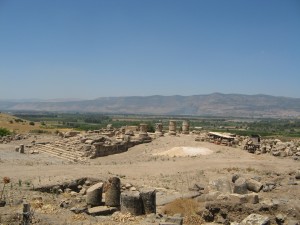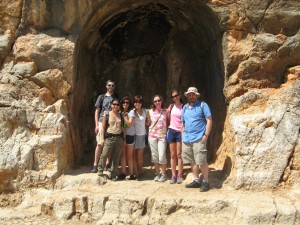Perhaps my first impression of Israel during our sleepy two-hour bus ride from Tel Aviv to K’far Szold was of the region’s lush landscape. Northern Galilee does not at all fit my previous mental image of Israel as an arid, barren desert land populated by camels and scorpions. Although the climate is certainly hot and dry, the natural springs and the Jordan River bring a wealth of agriculture and vegetation to the region. I was particularly happy to find fruit and olive trees, as well as grape vines, covering the kibbutz, in the slim hope that I will enjoy one or two juicy, delicious snacks before I return home in a month. Indeed, the kibbutz’s organic apples and apricots served at lunch are grown on its property. I was also pleasantly surprised at Israel’s level of development, and have thoroughly enjoyed certain first-world amenities, such as the kibbutz’s large, gorgeous pool and my room’s air conditioner, that I do not have access to at home.
Although we have not yet begun work on our squares at Omrit, I have loved becoming more familiar with the site and its surroundings. Perhaps most unexpected for me was the gorgeous views from the temple, which is situated relatively high up on a hill in the Golan Heights; the temple looks out over the green Hula Valley, nestled between the browner, dramatic foothills of Mount Hermon. On my first day of work at the site, after a long morning of “housecleaning” in the altar area of the temple, Elvira and I helped clear and weed areas east of the temple around the wadi. This region, uphill from the temple itself, was the site of a Byzantine town, and this season’s research will address the extent of the town during Roman times as well. I will be interested to watch future research unfold the town’s possible Roman foundations; I would love to gain a closer look at every day life for a citizen of Omrit and learn more about an individual’s daily relationship with the temple. I am also fascinated by the temple’s status as a stopping point on the road from Tyre to Damascus. How would a foreign visitor’s understanding of the temple have differed from a local’s? How did the temple’s (possible) status as an Augusteum interact with its more local connection with the obscure goddess Echo? How involved were members of the region directly around Omrit in temple life?
A trip to neighboring site Banias today raised even more questions. Banias, around 3 km down the road from Omrit, is a series of Hellenistic and Roman temples dedicated to the god Pan, as well as to Zeus. Pan’s connection with Echo connects this temple with that at Omrit. Yet what was the relationship between these two temples? I wonder whether Banias would also have acted as a stopping point on the way from Tyre to Damascus; did the temples compete for the attentions of visitors? Was one temple more focused on the local population? Would townspeople at Omrit have also participated in religious life at Banias? Perhaps future research at Omrit will uncover its relationship with the regions surrounding it.


